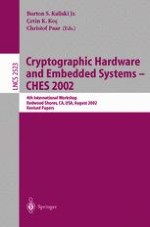ThesearetheproceedingsofCHES2002,theFourthWorkshoponCryptographic Hardware and Embedded Systems. After the ?rst two CHES Workshops held in Massachusetts, and the third held in Europe, this is the ?rst Workshop on the West Coast of the United States. There was a record number of submissions this year and in response the technical program was extended to 3 days. As is evident by the papers in these proceedings, there have been again many excellent submissions. Selecting the papers for this year’s CHES was not an easy task, and we regret that we could not accept many contributions due to the limited availability of time. There were 101 submissions this year, of which 39 were selected for presentation. We continue to observe a steady increase over previous years: 42 submissions at CHES ’99, 51 at CHES 2000, and 66 at CHES 2001. We interpret this as a continuing need for a workshop series that c- bines theory and practice for integrating strong security features into modern communicationsandcomputerapplications. Inadditiontothesubmittedcont- butions, Jean-Jacques Quisquater (UCL, Belgium), Sanjay Sarma (MIT, USA) and a panel of experts on hardware random number generation gave invited talks. As in the previous years, the focus of the Workshop is on all aspects of cr- tographic hardware and embedded system security. Of special interest were c- tributionsthatdescribenewmethodsfore?cienthardwareimplementationsand high-speed software for embedded systems, e. g. , smart cards, microprocessors, DSPs, etc. CHES also continues to be an important forum for new theoretical and practical ?ndings in the important and growing ?eld of side-channel attacks.
